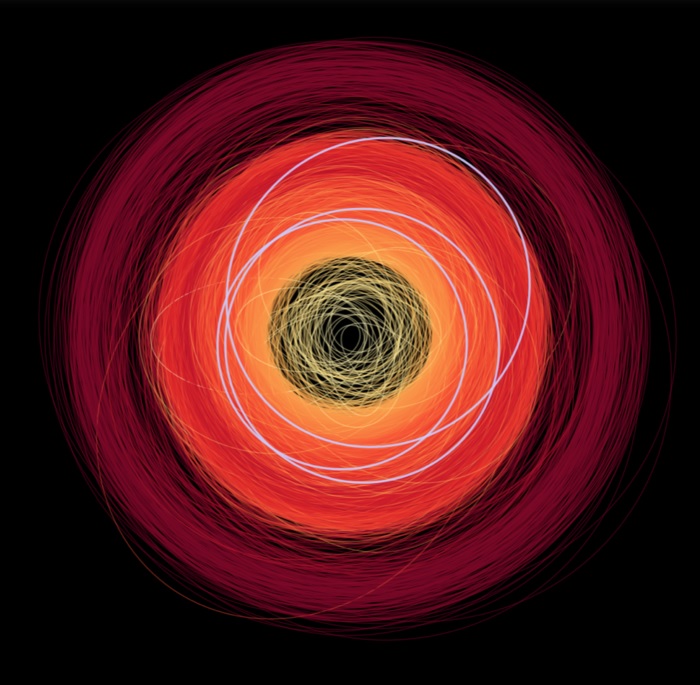Four Asteroids Travel Along Tilted Orbits in Trance-Like ESA Video
Almost a million miles away from Earth, the European Space Agency's (ESA) Gaia spacecraft is gazing at more than a billion stars. And as the instrument ambitiously maps these stellar positions, the mission is also discovering new asteroids, whose orbits are featured in a new video.
The animation makes the orbits of Gaia's first four asteroid discoveries pop out in pink, and the orbits of the 200 brightest rocks appear in green, according to ESA officials in a June 28 statement.
The video begins by looking at these orbits from a bird's-eye perspective, as if the viewer is looking down at the plane of the solar system from above.
Related: Photos: Gaia Spacecraft to Map Milky Way Galaxy
It's akin to looking down at a sunny-side up egg in a pan: the circular egg white is like the flat disc region — about level to the solar equator — where the orbits of most objects are found as they travel around the sun, which would be the yolk in this breakfast-themed example.
As the video continues, the perspective shifts until the audience is looking at these asteroid orbits head-on, as if a viewer bends down and looks at the sunny-side up egg at eye-level with the pan. And it's at this point that viewers can see that the pink orbits are at a significant angle relative to the disc.
The pink orbits mark the four Gaia-discovered objects, which belong to the "main belt"of asteroids found between the orbits of Mars and Jupiter. Gaia spotted three of these featured asteroids — temporarily designated as 2018 YK4, 2018 YL4 and 2018 YM4 — in December 2018, and the fourth — 2019 CZ10 — in February 2019. Ground-based observatories later confirmed all four discoveries.
Breaking space news, the latest updates on rocket launches, skywatching events and more!
According to ESA, these four space rocks orbit at a tilt of 15 degrees or more with respect to the solar system plane. Gaia can make these impressive observations because it is sitting in the gravitationally-stable spot known as Lagrange point 2 (L2) located about 930,000 miles (1.5 million kilometers) from Earth.
ESA officials added that this location gives the spacecraft a great vantage point to find more such objects in the future and to help characterize their movements.
The animation was published two days before the UN-sanctioned Asteroid Day on June 30, which takes place to raise awareness about space rocks near and far, and what humanity can do to protect the planet from a hefty impact.
- See the Earth, Moon and Asteroid Bennu in a Single Photo
- Queen's Brian May Outlines Asteroid Deflection Mission
- These Photos of Asteroid Ryugu from the Successful MASCOT Landing Are Amazing
Follow Doris Elin Salazar on Twitter @salazar_elin. Follow us on Twitter @Spacedotcom and on Facebook.

Doris is a science journalist and Space.com contributor. She received a B.A. in Sociology and Communications at Fordham University in New York City. Her first work was published in collaboration with London Mining Network, where her love of science writing was born. Her passion for astronomy started as a kid when she helped her sister build a model solar system in the Bronx. She got her first shot at astronomy writing as a Space.com editorial intern and continues to write about all things cosmic for the website. Doris has also written about microscopic plant life for Scientific American’s website and about whale calls for their print magazine. She has also written about ancient humans for Inverse, with stories ranging from how to recreate Pompeii’s cuisine to how to map the Polynesian expansion through genomics. She currently shares her home with two rabbits. Follow her on twitter at @salazar_elin.

